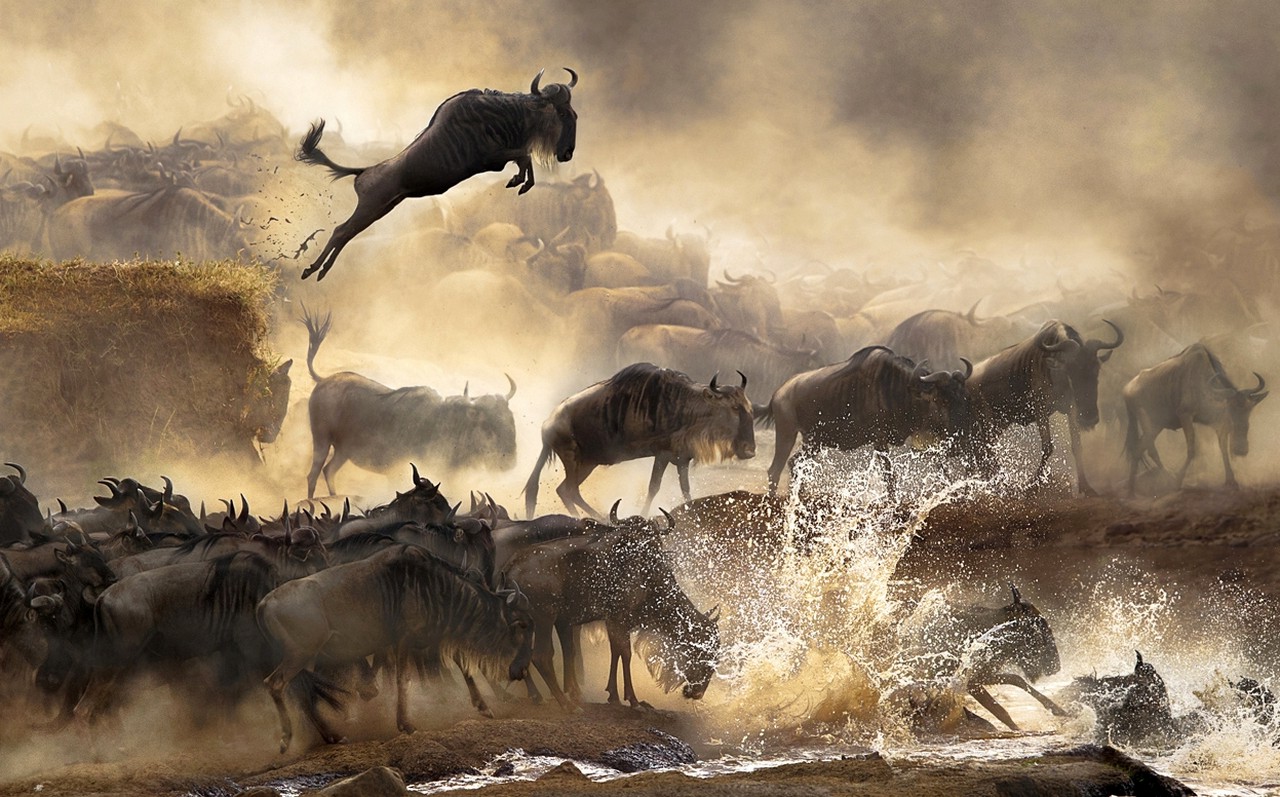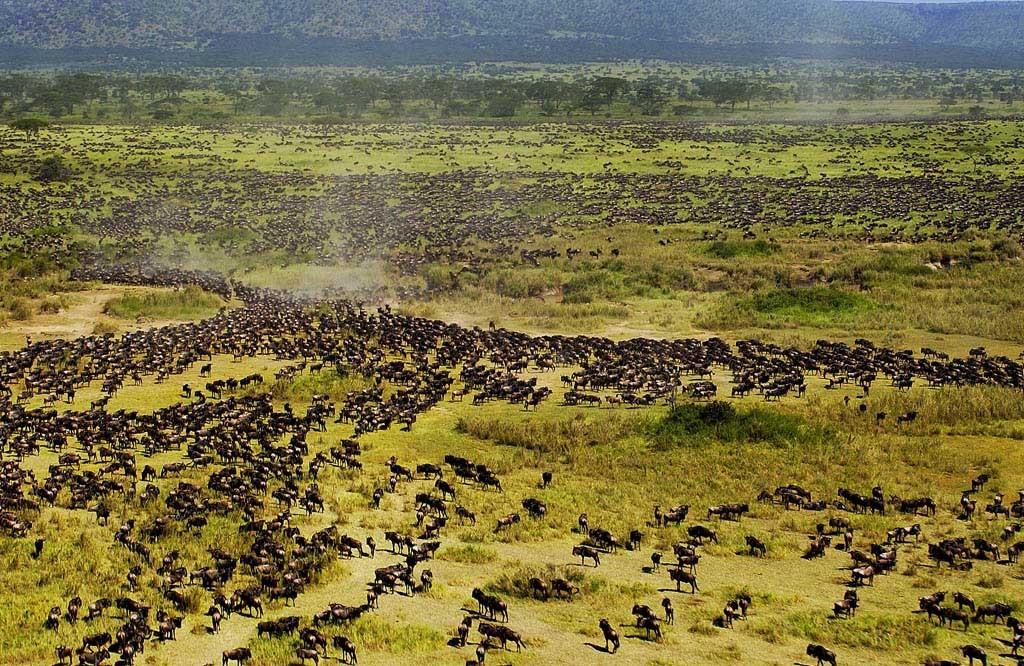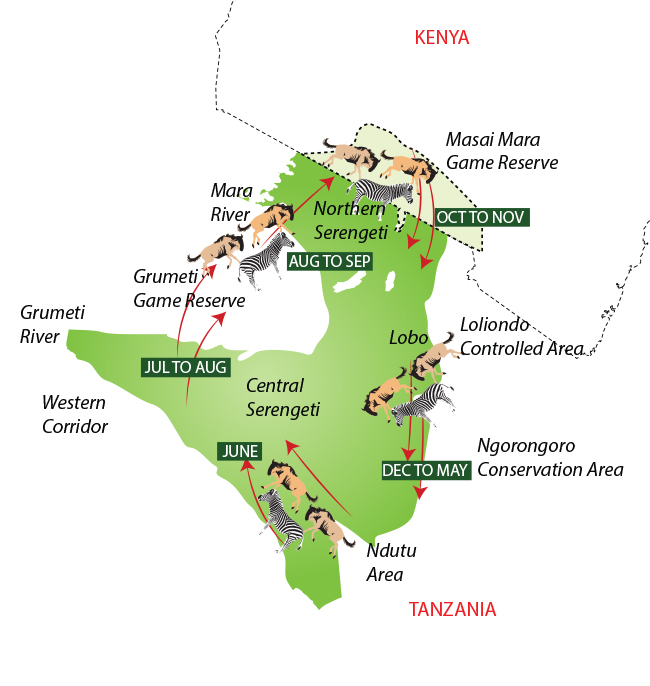Your cart is currently empty!

The Great Wildebeest Migration, Serengeti Wildebeest Migration
Our East Africa team explain why the migration of wildebeest around the Serengeti and Masai Mara is one of the world’s great wildlife spectacles, and how you can plan your safari to include it.
East Africa’s ‘Great Migration’ is not to be missed. Watching the herds of wildebeest, as they plunge across the hazardous waters of the Mara River in their tens of thousands, has inspired safari goers for generations.
However there’s far more drama to the Migration than just the crossings, with amazing sights to be seen year round; from the birthing season on the southern Ndutu Plains to the seemingly endless lines of animals winding their way north through the western Serengeti in search of the best grazing.

On an annual cycle, the herds, which can number in the region of 1.4 million wildebeest and some 200,000 zebra and gazelle, embark on a perilous journey that takes them clockwise through the expanse of Tanzania’s Serengeti into Kenya’s Masai Mara on a journey of survival. Sensing the distant rains, the herds move across the plains in search of fresh grass but attracting the resident predators, ready to pick off the weak or unwary.
The wildebeest migration is a continuous cyclical process that occurs primarily in the Serengeti National Park in Tanzania and to a lesser extent the Masai Mara National Reserve in Kenya. One and a half million wildebeest accompanied by hundreds of thousands of zebra, gazelle, eland, and impala move in a clockwise direction over hundreds of kilometers in a constant search for green pasture and freshwater. This movement follows a more-or-less regular pattern every year.
Along the 800 kilometer route, the wildebeest encounter many dangers, including numerous predators such as lion, leopard, cheetah, hyena, and crocodile preying on the young, old, weak, and infirm; hazardous floods; the hot tropical sun; tsetse flies; and exhaustion. The great Serengeti wildebeest migration is the movement of the Serengeti’s wildebeest, accompanied by zebra, and smaller numbers of Grant’s gazelle, Thomson’s gazelle, eland and impala.
The migration is considered one of the world’s most famous natural spectacles and something not to be missed by photographers and wildlife enthusiasts.
WHEN IS THE BEST TIME TO SEE THE MIGRATION?
There is no one best time to see the migration, as there are always opportunities to view the immense herds, but there are better times of year to observe different aspects of the process. However, as the exact timing of the migration is dependent on the rain, it can be difficult to predict with any certainty when and where the herds will be and what they may be doing. This inconsistency is more common with the advent of global climate change. An unusually heavy or light rainfall at an unexpected time could completely alter the movement of the herds.

HOW DOES THE MIGRATION PROCEED?
The annual migration through the Serengeti and into the Masai Mara is driven by rainfall patterns, which can vary from year to year. Therefore the movement of the herds will vary in timing and location from one year to the next. The migrating animals generally stay on the western side of the Serengeti plain as they move from south to north, and on the east side when moving north to south, but there is also plenty of zig-zag along the way, especially as large groups break off from the main herd.
As it is cyclical, there is no beginning nor ending time or place. In December to March, the wildebeest are concentrated in the southern Serengeti, where calves are born during a period of three weeks in February. Once the newborns are strong enough to walk long distances and the long rainy season has begun, the herds commence their journey northward toward more desirable fresh grasses and abundant water enabled by the rainfall.
WHAT IS THE GENERAL PATTERN?
November: Southward movement (Loliondo and Lobo areas of the eastern Serengeti).
December to March: Calving (Ndutu area of the southern Serengeti).
April to May: Green season (southwest and central Serengeti).
June to July: Northward movement (Western Corridor of the Serengeti).
August to September: River Crossings (northern Serengeti).
October: Grazing and localized movement (northern Serengeti and Masai Mara (Kenya)
THE GREAT MIGRATION MONTH BY MONTH
JANUARY TO MARCH
The story begins in the latter half of January as the herds converge on the short grass plains of the southern Serengeti and the neighbouring Ngorongoro Conservation Area. Here the females give birth to their young in the safety of numbers that millions of animals bring, gorging on the nutrient rich ‘super grass’ fed by volcanic substrate formed long ago. February moves into March and the herds begin to exhaust the short grasses and move northwest to the southern and central Serengeti areas of Kusini and the Seronera Valley. The young animals are growing stronger.
APRIL TO JUNE
As March moves into April and May the ‘long rains’ fall, drawing the herds toward the Western Corridor and the first of the river crossings. While a breakaway group of animals, often comprised of young males, move north, by June the majority of the herds are stomping and snorting on the banks of the Grumeti River. The numbers continue to mass, until the first of the animals plunge into the river to risk the teeth of the crocodiles gathered in anticipation and the strong flow of river waters that have been swollen by the floods of the rains.
JULY
The rain becomes a distant memory and the herds continue north, converging on the final barrier of the Mara River, the geographic boundary between the Serengeti of Tanzania and the Masai Mara of Kenya. This is the famous time of multiple river crossings, when the herds crowd into the confined space of the Masai Mara, turning the grasslands into a shifting mass of hides, fly-blown and chaotic. The wildebeest, zebra and gazelles are driven by their primal instinct to keep moving to find fresh grazing, while remaining alert enough to avoid the big cats that lurk, waiting for their next meal.
AUGUST TO OCTOBER
Throughout this time, the herds remain in the Mara and the northern Serengeti, repeatedly splitting into sub-groups that cross and re-cross the Mara River, seemingly forgetful of the danger, driven purely by instinct.
NOVEMBER TO DECEMBER
As the grasses are exhausted and the birth time approaches, the herds will cross the Mara for the last time and wander back south, through the Serengeti. From here, they’ll continue onto the short grass of Ndutu and the place of new beginnings.
FACTS ABOUT THE MIGRATION
- In the late 1800s, a serious outbreak of rinderpest (an infectious disease of ruminants) wiped out 95 percent of the cattle in Africa and also other vulnerable wildlife, including the Serengeti wildebeest. By the 1930s there were estimated to be only 100,000 wildebeest left in the Serengeti. It wasn’t until scientists managed to eradicate rinderpest in the 1960s that wildebeest numbers began to build back up. Within 20 years, the population of wildebeest had risen to around 1.4 million and it has remained at that level ever since
- The Great Migration is the largest overland migration of mammals in the world. A similar cycle with its dramatic elements can be seen nowhere else in the world.
- The herds travel a total of 800km (500 miles) or more during each cycle.
- Every year during the journey, around 250,000 wildebeest and 30,000 zebras die from thirst, hunger, exhaustion and, of course, predators.
- Newborn calves are able to run alongside their mothers within just a few minutes after birth.
- Studies have shown that the migration phenomenon occurs without guidance, as it happens instinctively. This may explain why the herd often splits into smaller groups heading in different directions (particularly as they move northward and southward). Consequently, at times wildebeest herds can be found to be covering more than half of the Serengeti.
- Zebra and wildebeest within the herd engage in a mutually beneficial relationship. They each eat different parts of the same grasses and plants. While grazing in harmony they both keep an eye on predators and alert the other species. Furthermore, zebra are often the ones who walk onward while the wildebeest follow.
- With millions of animals moving in unison, the impact on the landscape can be significant. This impact is vital to the Serengeti’s biodiversity. The cycle of grazing enables new grass to grow and regenerate. And in addition to the higher-order predators, scavengers and birds such as vultures rely on the casualties of the wildebeest migration for their own survival.
Leave a Reply